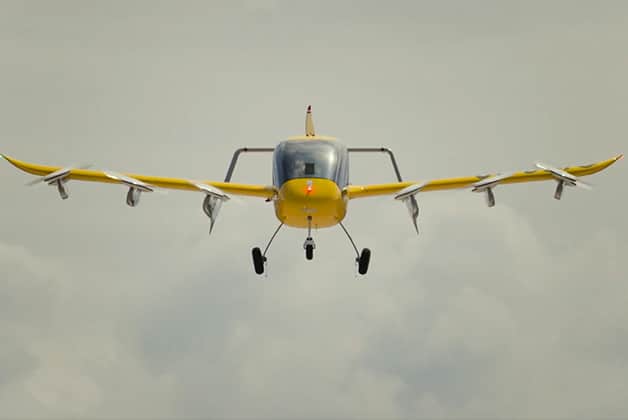Aerospace
Wisk Aero Completes First-Ever Public Demonstration Flight at EAA AirVenture

Wisk Aero, a global leader in Advanced Air Mobility, has accomplished the world’s first public demonstration flight of a completely autonomous, electric vertical takeoff and landing (eVTOL) fixed-wing air taxi. The company’s first public display of its 5th Generation autonomous, eVTOL technology demonstrator (Cora) occurred during the milestone flight at EAA AirVenture.
Wisk conducted a multi-transition flight in which the air taxi converted four times from hover to wing-borne flight. The flight also included multiple maneuvers that demonstrated the unique capabilities of the aircraft, such as hover, 360-degree turns in place, and more.
Brian Yutko, CEO of Wisk, stated, “We’re thrilled to demonstrate the autonomous technology underlying our self-flying initial approach. This exhibit shows how autonomous technology and electric propulsion have advanced to a ready stage. Together with the advancements we’re making towards Type Certification for our sixth-generation air taxi, we’re demonstrating that autonomy is a reality right now. Within this decade, we hope to introduce the first passenger service on an entirely electric, self-driving air taxi.
FAA Recruiting Pilots at AirVenture for Research Study(Opens in a new browser tab)
Wisk’s public demonstration flight continues the company’s history of aviation firsts, which also includes the first full transition of an eVTOL aircraft in the world (1st Generation air taxi), the first piloted flight of an all-electric, fly-by-wire aircraft that is human-rated in the world (2nd Generation air taxi, 2015), and the first piloted full transition flight of an eVTOL aircraft that is human-rated in the world (3rd Generation air taxi, 2017).

Aerospace
Boeing Transfers Rocket Stage to NASA, Paving Way for Human Moon Mission

Boeing has achieved a significant milestone by providing NASA with the second core stage of the Space Launch System (SLS) rocket.
This crucial component, crafted at NASA’s Michoud Assembly Facility (MAF), is set to propel the Artemis II crew into lunar orbit, marking humanity’s return to deep space after a 50-year hiatus.
The monumental Boeing-built rocket stage, the largest element of the Artemis II mission, will embark on a journey aboard the Pegasus barge, traveling 900 miles to NASA’s Kennedy Space Center.
Comparison of two legendary aircraft B777x vs B747 aircraft:Click here
Upon arrival, it will be meticulously integrated with other essential Artemis II components, including the upper stage, solid rocket boosters, and NASA’s Orion spacecraft within the iconic Vehicle Assembly Building. This intricate integration process is a vital step toward the eagerly anticipated Artemis II launch, slated for 2025.
“Boeing-built products helped land humankind on the moon in 1969, and we’re proud to continue that legacy through the Artemis generation,” remarked Dave Dutcher, vice president and program manager for Boeing’s SLS program. “Together, with NASA and our industry partners and suppliers, we are building the world’s most capable rocket and paving the way to deep space through America’s rocket factory in New Orleans.”
NASA, Lockheed Martin Reveal X-59 Quiet Supersonic Aircraft:Click here
The delivery of Core Stage 2 marks a significant achievement in the evolution of the SLS rocket. Towering over 200 feet and powered by four RS-25 engines, this core stage, coupled with two solid-fueled booster rockets, will generate a staggering 8.8 million pounds of thrust. This immense power is crucial to launching Artemis II and future missions into the vast expanse of space.
The SLS rocket stands unparalleled in its capability to transport both crew and substantial cargo to the moon and beyond in a single launch. Its extraordinary capacity will facilitate the delivery of human-rated spacecraft, habitats, and scientific missions to destinations including the moon and Mars, ushering in a new era of space exploration.
-

 Travel1 week ago
Travel1 week agoAir India to Expand US Operations with Three New Routes After a Decade
-

 Travel2 weeks ago
Travel2 weeks agoWhy We Should Avoid These Stamps in a Passport
-

 Airlines1 month ago
Airlines1 month agoInvestigations Reveal Fake Chinese Titanium in Boeing and Airbus Jets
-

 Tech4 weeks ago
Tech4 weeks agoChina’s CATL Plans 1,800-Mile Electric Plane Launch by 2027
-

 Airport3 days ago
Airport3 days agoTop 10 Largest Airports in the World by Size
-

 Aerospace4 weeks ago
Aerospace4 weeks agoChina’s Fighter Jets Turn Wings into Autonomous Drones
-

 Airlines4 days ago
Airlines4 days agoAir India Rolls Out A350s for Delhi-New York JFK and Newark Routes
-

 Defence3 weeks ago
Defence3 weeks agoBoeing Enhances Chinook with New Engines and Block II Upgrades at $96 Million







